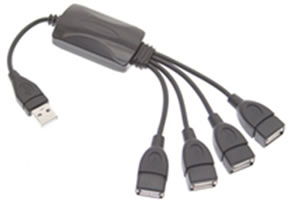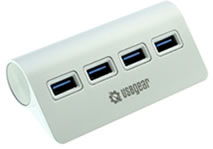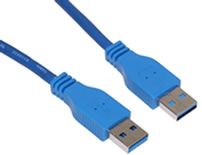A non technical and casual look at USB hubs.
Let's preface this part of the article with a bit of clarity about USB 3.0 and 3.1. Until recently when we use the term USB 3, we refer to it pertaining to it data speed capability. In early 2015 USB 3.0 was renamed to USB 3.1 Generation 1 (Gen1), this is the same specification with a different name. USB 3.1 Generation 2 (Gen2) will be capable of up to 10Gbps data transmission speeds.
USB (Universal Serial Bus) was developed in the 1990's and has led to many combinations of electronic peripherals and accessories for computers. The USB hub has become one of the most used computer peripherals since the Universal Serial Bus was introduced into host desktop and notebook systems in the mid 90's. Often built into computers systems, keyboards, and monitors, the USB hub provides a way of expanding or growing one's peripheral usage and network whether it is a gamer, technician, or repairman.
of electronic peripherals and accessories for computers. The USB hub has become one of the most used computer peripherals since the Universal Serial Bus was introduced into host desktop and notebook systems in the mid 90's. Often built into computers systems, keyboards, and monitors, the USB hub provides a way of expanding or growing one's peripheral usage and network whether it is a gamer, technician, or repairman.
USBGear provides many USB hub formats and has kept up with USB standards since version 1 and has followed through with today's current standard 3.1. USB has provided an increase in data speed taking what had been many hours of data transfer time in the form of CD's and turning it into mere minutes with thumb drives, hard drives or other data storage devices.
The once infantile USB hub has grown into an incredible tool for networks, storage, computer accessories, data transfer, and many more applications.
What's the USB 3.0 Hub deal?
 The USB 3.0 hub deal is all about speed, speed, and more speed, the data transfer kind that is! As mentioned above, the USB standard has grown tremendously in a fairly short amount of time from data transfers of only 12Mbps in USB version 1.1 to an incredible 5Gbps and soon to be 10Gbps with USB 3.1 hubs, but I digress, we're talking about the USB 3.0 hub and "what the deal is". This a big deal in comparison to earlier versions, a USB 3.0 hub can be a bus powered USB hub, or, can be a device that requires a power adapter to operate, it can also be a combination of both looking at the application it might be used for. USB 3.0 began the SuperSpeed revolution and gave us the ability to transfer data at up to 5Gbps, it also forced the computer industry into a new and higher technology, the development of a USB 3.0 hub was just a beginning to USB 3.0 cables and other adapters that have come about in the electronic market and is still growing!
The USB 3.0 hub deal is all about speed, speed, and more speed, the data transfer kind that is! As mentioned above, the USB standard has grown tremendously in a fairly short amount of time from data transfers of only 12Mbps in USB version 1.1 to an incredible 5Gbps and soon to be 10Gbps with USB 3.1 hubs, but I digress, we're talking about the USB 3.0 hub and "what the deal is". This a big deal in comparison to earlier versions, a USB 3.0 hub can be a bus powered USB hub, or, can be a device that requires a power adapter to operate, it can also be a combination of both looking at the application it might be used for. USB 3.0 began the SuperSpeed revolution and gave us the ability to transfer data at up to 5Gbps, it also forced the computer industry into a new and higher technology, the development of a USB 3.0 hub was just a beginning to USB 3.0 cables and other adapters that have come about in the electronic market and is still growing!
The USB 3.0 hub also allowed its user to perform normal charging for devices such as digital camera, mobile phones, and PDA and allow data to pass through utilizing the device while charging. The powered USB hub is a hub that is generally powered by an AC adapter to allow more power to the connected devices to the hub if needed, as an example, a powered USB hub may have an external hard drive connected to it and hard drive may need additional power to operate correctly.
digital camera, mobile phones, and PDA and allow data to pass through utilizing the device while charging. The powered USB hub is a hub that is generally powered by an AC adapter to allow more power to the connected devices to the hub if needed, as an example, a powered USB hub may have an external hard drive connected to it and hard drive may need additional power to operate correctly.
What we should not forget about a USB 3.0 hub is that it needs a USB 3.0 cable to provide its speed, the hub will only put out the speed if it connected to a USB 3.0 cable and that cable connected to the USB 3.0 port of your host device whether it's a Dell PC, HP Laptop, MacBook Pro, Surface Pro, or other host system that has a USB 3.0 port built into it. With this said, the version of this standard is also backward compatible with USB 2.0, so you can have everything connected properly including the hub and cable and still connect a lower version device to the hub because that device will supply the speed it was built for.
Are USB 3.0 Cables Important?
The USB 3.0 cable, a necessary component to acquiring the 5Gbps speed that the USB 3.0 standard calls out is in itself a valuable piece of electronic equipment. Just as there are many different USB versions, there are just as many if not more styles of the USB 3.0 cables, here are some of the variables:
Length, connector type (male type A, female type A, micro B, micro A, Type B male and female, USB-C reversible, screw lock, right angle, left angle) just to name a few.
Each style of USB 3.0 cable connector has a function to fit the application it is being used for, a USB 3.0 micro-A or B connector may be used with a hub or hard drive enclosure if supported while a USB 3.0 Type-B Male connector may be used as a USB printer port connection, the list goes on but needless to say, there is a USB cable and connector for every USB application.
Is it a USB hub or cable
Briefly, there are some USB 2 and 3 cables that I'll refer to as a sub hub at the moment. These are USB cables that are active, meaning that they use an external power adapter to boost power to keep the signal going. These sub hubs (also known as extension or extender cables) act as a built in USB hub at the connection point to carry the USB signal on to the device it's intended for. These active sub hub cables or extender cables can be acquired in various lengths from 20 to 200 feet allowing the user to carry the USB signal well past its USB specification of 5 meter length.
In our following articles, more will be discussed about the USB extenders or USB extension cables. Other technologies will be discussed that combine USB and serial communication protocols for USB to Serial applications such as RS232, RS422, and RS485 signals for terminal communication, barcode scanners, or industrial weighing scales in our versatile, technologically driven world.
Read other USB hub articles as we provide information that may be needed for future purchases
